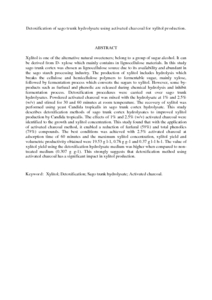Citation
Mustapa Kamal, Siti Mazlina and Abdullah, Abdul Ghani Liew and Abdullah, Norhafizah and Mohamad, Nurul Lina
(2011)
Detoxification of sago trunk hydrolysate using activated charcoal for xylitol production.
Procedia Food Science, 1 (1).
pp. 908-913.
ISSN 2211-601X
Abstract
Xylitol is one of the alternative natural sweeteners; belong to a group of sugar alcohol. It can be derived from D- xylose which mainly contains in lignocellulose materials. In this study sago trunk cortex was chosen as lignocellulose source due to its availability and abundant in the sago starch processing industry. The production of xylitol includes hydrolysis which breaks the cellulose and hemicellulose polymers to fermentable sugar, mainly xylose, followed by fermentation process which converts the sugars to xylitol. However, some by-products such as furfural and phenolic are released during chemical hydrolysis and inhibit fermentation process. Detoxification procedures were carried out over sago trunk hydrolysates. Powdered activated charcoal was mixed with the hydrolysate at 1% and 2.5% (w/v) and stirred for 30 and 60 minutes at room temperature. The recovery of xylitol was performed using yeast Candida tropicalis in sago trunk cortex hydrolysate. This study describes detoxification methods of sago trunk cortex hydrolysates to improved xylitol production by Candida tropicalis. The effects of 1% and 2.5% (w/v) activated charcoal were identified to the growth and xylitol concentration. This study found that with the application of activated charcoal method, it enabled a reduction of furfural (58%) and total phenolics (78%) compounds. The best conditions was achieved with 2.5% activated charcoal at adsorption time of 60 minutes and the maximum xylitol concentration, xylitol yield and volumetric productivity obtained were 19.53 g l-1, 0.78 g g-1 and 0.37 g l-1 h-1. The value of xylitol yield using the detoxification hydrolysate medium was higher when compared to non-treated medium (0.307 g g-1). This strongly suggests that detoxification method using activated charcoal has a significant impact in xylitol production.
Download File
![[img]](http://psasir.upm.edu.my/23202/1.hassmallThumbnailVersion/Detoxification%20of%20sago%20trunk%20hydrolysate%20using%20activated%20charcoal%20for%20xylitol%20production.pdf)  Preview |
|
PDF (Abstract)
Detoxification of sago trunk hydrolysate using activated charcoal for xylitol production.pdf
Download (84kB)
| Preview
|
|
Additional Metadata
Actions (login required)
 |
View Item |

